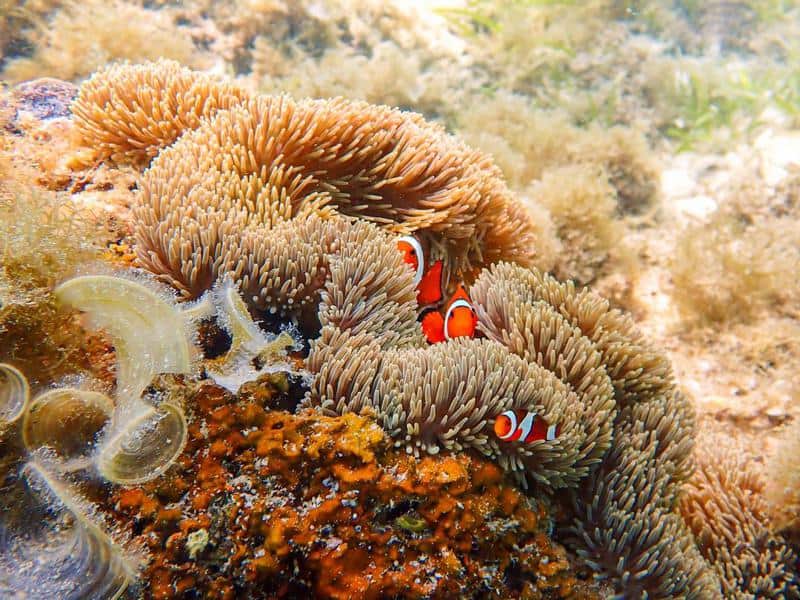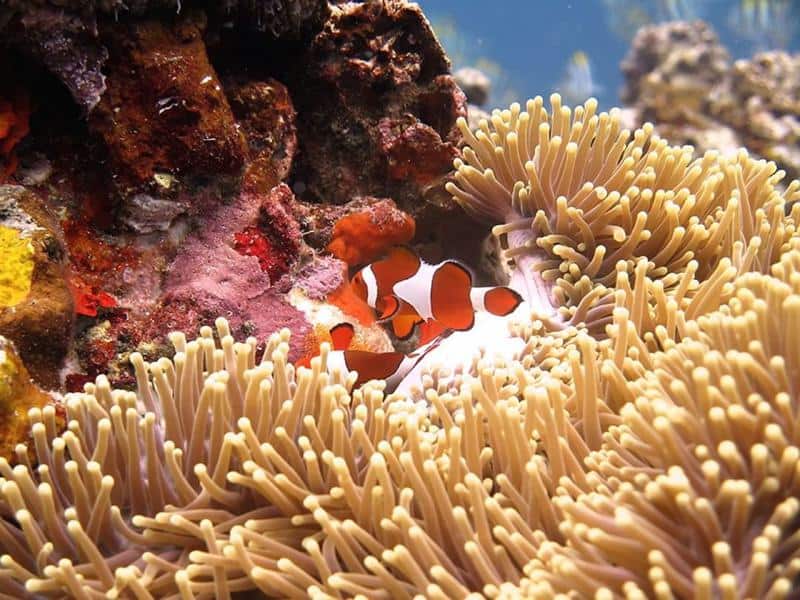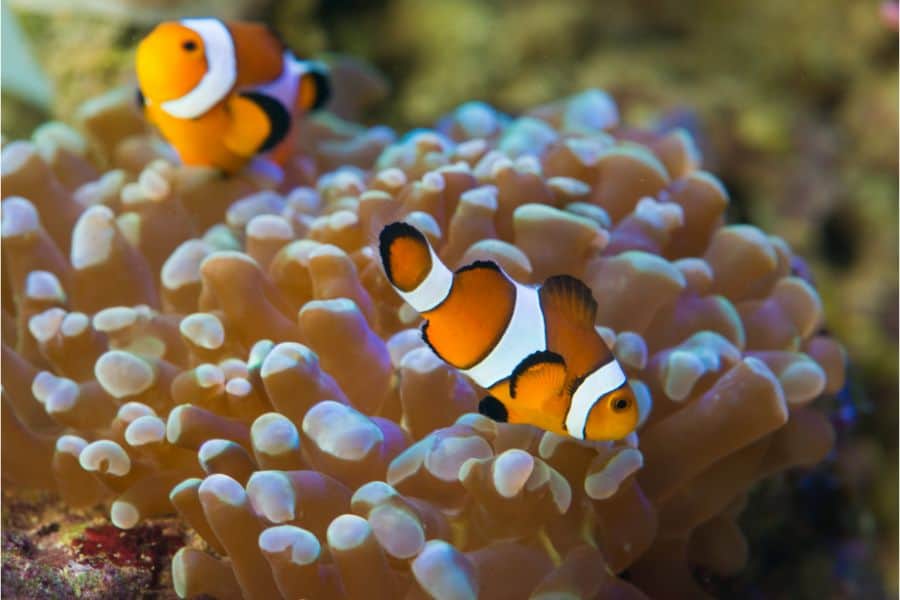In keeping our aquarium fish, we are very keen on knowing their preferred parameters and ideal water conditions.
We are very particular about maintaining their temperature range, ph, hardness, and water chemistry. We even invest in mechanical accessories and test kits to help us determine the state of their water environment.
However, keeping our aquarium fish healthy is not just about preserving their habitat as close to their natural environment.
Giving them the right foods is equally important. We have to remember that food is their main fuel for growth and giving them proper nutritious food guarantees their overall development.
In this article, we will feature the natural sources of nourishment of Clownfish in the wild and the ideal food sustenance to give when they are kept in an aquarium.
The Omnivorous Nature of Clownfish
There are over 30 species of Clownfish worldwide. Although they vary in size, color, and pattern, what is common to all Clownfish species is that they have a limited territory.
Aside from the confines of the sea anemone they are living with (which they are highly attached to), they occasionally wander out of their domain, but only for a few inches away.
In other words, the swimming space of Clownfish is very restricted, and with the very little room they have, they should eat whatever food is available.
The good news is that Clownfish are not picky eaters. They can eat both plant and animal materials, making them an omnivore.
Clownfish Food in The Wild
The sources of food for Clownfish in the wild are endless. Remember that coral reefs and reef-associated structures are the main habitats of Clownfish in the wild, and the nourishment of these wild habitats comes from larger bodies of water, like seas and oceans.
Foods Derived Within Their Sea Anemones

Demonstrating the perfect example of a mutual relationship, Clownfish and Sea Anemones are obligate symbionts. In simple terms, they are mandatory partners. They highly depend on each other for survival and this is why Clownfish spend most of their time near Sea Anemones.
Clownfish are immune to the stinging tentacles of Sea Anemones. With their mostly bright color and playing along the tentacles, Clownfish attract and lure in nearby fish towards the Sea Anemone tentacles.
Once a susceptible fish is near, they are stung and eaten alive by the Sea Anemone. In exchange for the food the Clownfish have lured in, Sea Anemones reward the Clownfish by giving them a protected refuge and food.
But what kind of food?
Trapped Algae
Algae has no true roots and this is why some of them float freely in the water. As they are taken along by the current, some algae may end up in the Sea Anemone tentacles.
Algae trapped in the tentacles are not consumed by the Sea Anemone since they are exclusively carnivores. With the availability of food that is within reach, algae become an instant food source for Clownfish.
Unconsumed Food
Sea Anemones are voracious carnivores. In the case of a tiny fish, after they are paralyzed by the stinging cells, they are led to the central mouth of the Sea Anemone and devoured as a whole fish.
But despite having a greedy appetite, Sea Anemones will come to a point where they become full, yet continue to devour fish. In effect, the unconsumed part of the fish becomes an instant meal for Clownfish.
Undigested Food and Poop
Another effect of Sea Anemones being greedy eaters is the excretion of undigested food. But be aware that Sea Anemones have an incomplete gut and that their central mouth, where food comes in, is also where undigested food comes out.
Undigested food is usually released an hour or two after consuming a whole fish.
It is why Clownfish prefer to stay near the Sea Anemone’s mouth. Not only nipping on fresh meat as the fish is devoured whole, but they also have a creamy dessert later on as the Sea Anemones release their undigested food.
Similarly, it is in the central mouth that Sea Anemone excretes their poop. During hard times when food is scarce, Sea Anemone poop can become a food item for Clownfish.
Plankton as Main Clownfish Food in The Wild

The food items of Clownfish from Sea Anemones (whether in quantity or quality) are not enough for them. The bulk of a Clownfish’s nourishment still comes from the water that passes through its territory.
In general, plankton is the principal food source for Clownfish. They are composed of zooplankton (animals) and phytoplankton (plants) that naturally occur in huge numbers, and these microscopic organisms drift along to where the water current is going.
Clownfish are plankton pickers. They actively eat and prey on plankton as water passes through the sea anemone. It is the opposite of the passive feeding behavior of filter feeders, where they suck in water and filter in the planktonic food, like what the largest fish, the whale sharks, do.
Clownfish Food in The Aquarium
There are two possible setups for keeping Clownfish in a tank. It is either with or without Sea Anemones.
For Clownfish with Sea Anemones, do not expect your Sea Anemones to provide your Clownfish with ample amounts of undigested food as the fish you are keeping with them are most probably meant not to be eaten by them. With this, do not rely on your Sea Anemone in providing your Clownfish with supplemental foods.
Contrary to the abundance of food sources in the wild, an aquarium is a closed and artificial system and food may be limited. It is why you need to supply your tank-raised Clownfish with their food.
Here are some food items you can give to your Clownfish:
Commercial Feeds:
- marine pellets
- marine flakes
Frozen Foods (thawed):
- krill
- mysis
Live Foods:
- brine shrimp
Veggie Feeds:
- Nori
- Other seaweed sheets
Food for Baby Clownfish
On average, the lifespan of Clownfish is five years. If you are raising a group of Clownfish and able to keep them this long, chances are your Clownfish will produce offspring.
With baby Clownfish (even with juveniles or sexually immature), feeding can be challenging. The tiny size of their mouth requires them to be fed exclusively with plankton. Most aquarists do this by hatching rotifer cysts.
As your baby Clownfish grow, you can now shift to feeding them with brine shrimp and progress to the food items we mentioned as they mature.
Amount of Clownfish food
Providing the right amount of food to your Clownfish won’t just maintain their health but will also keep the parameters of your water stable.
Giving too much food is not just a guarantee that there will be excess food, but it is also a way of raising your ammonia level from increased metabolic waste and the rotting of unconsumed foods.
So, by how much?
Regardless of the food item you select, you can always follow the “eyeball method”. It means that the amount of food you will give your Clownfish corresponds to the size of their eyeball.
Of course, this is on the exemption for your baby Clownfish. Instead of the eyeball method, you need to have the ideal density of rotifers, which in this case is 10 rotifers per ml.
Fun fact: Counting rotifers requires a microscope and a glass slide. Place 1 ml of water in the glass slide and count all the rotifers you see.
Frequency of Feeding
Adult Clownfish are fed once a day. It means you have to give the eyeball-sized food straight away to them. However, for babies and juveniles, you should divide their food ration since their stomach is not yet large enough to take in the food all at once.
For juvenile Clownfish, feed them three times a day. It also implies that their food ration is divided in three parts.
Do not worry about the feeding frequency of your baby Clownfish. In order to grow fast, they eat as frequently and as much. So, make sure you provide them with the right density of rotifer.
Indications of An Underfed Clownfish
A Clownfish stomach is your external anatomical tool in determining whether they are underfed.
After feeding, you should expect your Clownfish will have a slightly bulging stomach. However, if their tummies are thin and look depressed, then it is a good indicator that they are underfed and that you need to increase the amount of their food ration.
Also Read: Best Clownfish Tank Mates
FAQs
Do Clownfish Eat Their Own Eggs?
Yes, but they eat their eggs not because of hunger.
After the females lay their eggs, the males do their part by fertilizing them with their sperm. Aside from this, the males are also responsible for taking care of and guarding the eggs. During tending, the male Clownfish eats any damaged and deformed eggs, and only the healthy eggs are left behind to hatch.
Eating unhealthy eggs is an evolutionary way of ensuring that only the good eggs are hatched, ensuring a healthy next generation of Clownfish.
Do Clownfish Eat Corals?
Clownfish are omnivores, and they eat both plants and animals. Despite being an animal, corals are not a staple of the Clownfish diet.
However, when corals and Sea Anemones grow close to each other, the tendency is that the Clownfish living within the Sea Anemone will bite the corals.
Since corals are covered with a hard exoskeleton, the Clownfish targets their soft polyps.
Final Words
Clownfish are lucky since they have multiple food sources, even in a closed system like an aquarium. Knowing all their food sources gives us the benefit of managing our Clownfish with ease.
At the end of the day, don’t just give Clownfish their food. Use the food to your advantage where you can train them by establishing a daily feeding time.
In this way, your Clownfish will go out of their Sea Anemone and greet you at the surface with excitement as you deliver to them their food.
